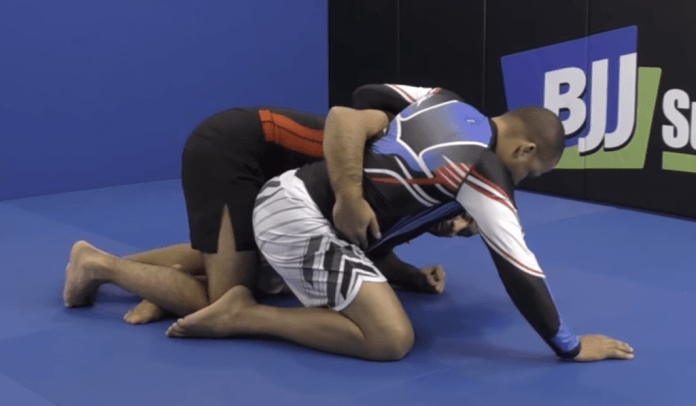
While you might argue that every roll in BJJ is much like a dogfight, there’s actually a specific BJJ Dogfight position. Moreover, you’ve probably already been there, but are probably unaware of it. While the BJJ Dogfight position is just as it sounds, a dogfight, it does offer some really cool options. Today, we’ll be covering the “bottom” position of the dogfight, which is the more attacking of the two. What you need to remember is that this position is much like the 50/50 guard, with both people having lots of options. In that sense, always remain careful and try not to spend too much time in the Dogfight.
The BJJ Dogofgith position is one of those strange sports most consider to as scramble. In essence, it is a powerful transitional position, as long as you know what you’re doing. Some things do come instinctually, like sweeping, but others will require a certain level of experience with the position. Furthermore, you’ll have to know how to get there and stay safe, since your opponent is going to have some quick attacking options as well. All in all, the dogfight is not something you want to pursue, but you definitely want to be know what to do once you end up in it. And that will inevitably happen more often than not.
BJJ Dogfight Position
So what exactly is the BJJ Dogfight position? Let me put it this way – it is the halfway point between the bottom half guard and every successful sweep you execute from there. Basically, it is a position where both grapplers are on their knees. While entangled in the Dogfight, the positioning of the arms is going to determine the outcome. As I previously stated, it’s pretty much a 50/50 situation. However, there are certain advantages to being the “bottom” grappler.
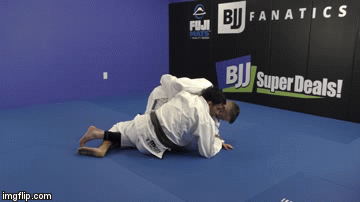
So, once you get a deep underhook you need to unlock your legs and turn to your knees. As you do that, you take the inside leg of the half guard out and wide. The knee of the other leg goes behind the knee of the opponent. This is key to obtaining a sound position that an opponent can’t just roll out of.
Now, the key to controlling the BJJ Dogfight position is in the underhook. You need to have the correct grip first, which comes in two main varieties. One is to latch on to the lat muscle on the opposite side and the other is to grab the shoulder. both open different avenues of attack, as you’ll soon see.
The Dogfight Game
When in the BJJ Dogfight position, you’re going to be constantly active. There’s no resting there like in the mount or closed guard. On the contrary, you’re either attacking or defending the position. Going back to half guard is certainly an option, but it will take you a step back instead of forward.
Before exploring some attacking options from the BJJ Dogfight position, let’s look at some defense staples. In terms of base and posture, you’re both in pretty much the same position on your knees and with one arm posted on the mats. The battle is determined by your underhook or the opponent’s Whizzer. In that sense, headlock attacks are very readily available to your opponent, particularly D’arce choke attacks. The positioning of the legs also opens up rolling kneebars to them, so you have to stay wary of these two major threats.
A good underhook with tight elbow control will go a long way to deter any imminent D’arce attacks. Conversely, a strong base with your weight towards your heels, along with the underhook, will prevent quick rollunder and leglocks. Apart from that, you have most of the upper hand, even though you’re the one with an underhook.
Rolling Wristlock
This is one of the slickest attacks you can do from the Dogfight position. Wristlocks are sneaky anyhow, and even though they’re legal from blue belt onwards, even black belts rarely expect them. They’re notoriously underrated for such an effective submission hold. For this move, aim for an underhook that ends up with a grip on the shoulder rather than the lat.
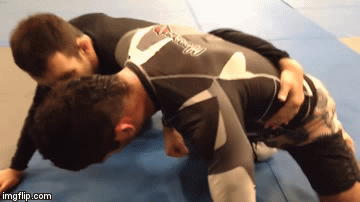
The Easiest BJJ Sweep
The easiest and most basic half guard sweep is actually one that is executed from the Dogfight position. While you might not know much about the position, you’ve certainly done this sweep.
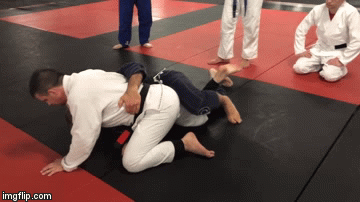

Headlock Attacks
Attacking the headlock is harder when you’re starting off with an underhook, but it is by no means impossible. Quite the contrary, headlocks form the BJJ Dogfight position are high percentage attack that ensures you end up with either top position or a tap.
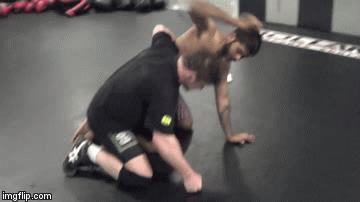
Triangle Choke
One of the coolest submission entries from the dogfight. It is also one of the easiest to mess up and end up on your back. However, when you get it right, you end up with one of the most attractive triangle entries apart from flying triangles.
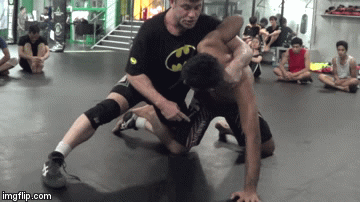
Spiderweb
The spiderweb position is one of the most versatile attacking positions in BJJ. While most people perceive it as only an armbar position, it offers much more than that. But that’s a subject for another article. Now, we’ll focus on obtaining the spiderweb from a dogfight.
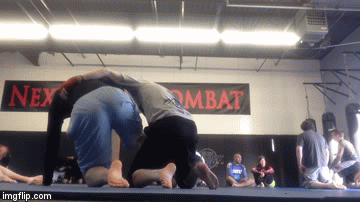
Final Words
The BJJ Dogfight position is a great attacking pitstop for everyone that likes to play half guard. In essence, there’s no playing offensive half guard without it. It doesn’t matter if you like Z-guard, lockdown, or another half guard variation. The Dogfight is the nexus for all half guard attacks that work. So make sure you give our attacking options a try, to help you get more out of the position than just a sweep.


![Darce Choke Encyclopedia – Origins, Mechanics and Variations [2025] BJJ, choke, Brabo, BJJ Darce Choke, D'arce Choke, Darce BJJ Choke](https://bjj-world.com/wp-content/uploads/2017/11/JungPoirierLeeYahoo-218x150.jpg)









![X-Guard Trickery Kyle Sleeman DVD Review [2025] X-Guard Trickery Kyle Sleeman DVD Review](https://bjj-world.com/wp-content/uploads/2025/03/x-guard-trickery-kyle-sleeman-dvd-review-218x150.png)
![Countering with Crab Ride Anthony Budion DVD Review [2025] Countering with Crab Ride Anthony Budion DVD Review](https://bjj-world.com/wp-content/uploads/2025/03/countering-with-crab-ride-anthony-budion-dvd-review-218x150.png)
![Closet Closed Guard Craig Jones DVD Review [2025] Closet Closed Guard Craig Jones DVD Review](https://bjj-world.com/wp-content/uploads/2025/03/closet-closed-guard-craig-jones-dvd-review-218x150.png)
![Xanadu Back Takes Levi Jones-Leary DVD Review [2025] Xanadu Back Takes Levi Jones-Leary DVD Review](https://bjj-world.com/wp-content/uploads/2025/03/xanadu-back-takes-levi-jones-leary-dvd-review-218x150.png)

![No-Gi Grapplers Guide To Front Headlock Joel Bane DVD Review [2025] No-Gi Grapplers Guide To Front Headlock Joel Bane DVD Review](https://bjj-world.com/wp-content/uploads/2025/03/no-gi-front-headlock-joel-bane-dvd-review-218x150.png)


![Dynamic De La Riva Guard Otavio Sousa DVD Review [2025] Dynamic De La Riva Guard Otavio Sousa DVD Review](https://bjj-world.com/wp-content/uploads/2025/02/dynamic-de-la-riva-guard-otavio-sousa-dvd-review-100x70.png)

![Crush The Guard Vagner Rocha DVD Review [2024] Crush The Guard Vagner Rocha DVD Review](https://bjj-world.com/wp-content/uploads/2024/10/crush-the-guard-vagner-rocha-dvd-review-100x70.png)
![The Buchecha Gi Takedown System DVD Review [2025] The Buchecha Gi Takedown System DVD Review](https://bjj-world.com/wp-content/uploads/2025/01/buchecha-gi-takedown-system-dvd-review-100x70.png)

![Xanadu Back Takes Levi Jones-Leary DVD Review [2025] Xanadu Back Takes Levi Jones-Leary DVD Review](https://bjj-world.com/wp-content/uploads/2025/03/xanadu-back-takes-levi-jones-leary-dvd-review-100x70.png)
![No-Gi Defense Xande Ribeiro DVD Review [2024] No-Gi Defense Xande Ribeiro DVD Review](https://bjj-world.com/wp-content/uploads/2024/11/no-gi-defense-xande-ribeiro-dvd-review-100x70.png)
![No-Gi Grapplers Guide To Front Headlock Joel Bane DVD Review [2025] No-Gi Grapplers Guide To Front Headlock Joel Bane DVD Review](https://bjj-world.com/wp-content/uploads/2025/03/no-gi-front-headlock-joel-bane-dvd-review-100x70.png)
![Underhooks With Uncle Jeff Glover DVD Review [2025] Underhooks With Uncle Jeff Glover DVD Review](https://bjj-world.com/wp-content/uploads/2025/02/underhooks-with-uncle-jeff-glover-dvd-review-100x70.png)
![Dynamic Headquarters Passing Jason Rau DVD Review [2024] Dynamic Headquarters Passing Jason Rau DVD Review](https://bjj-world.com/wp-content/uploads/2024/10/dynamic-headquarters-passing-jason-rau-dvd-review-100x70.png)

![Woj Lock the World Chris Wojcik Ankle Locks DVD Review [2024] Woj Lock the World Chris Wojcik Ankle Locks DVD Review](https://bjj-world.com/wp-content/uploads/2024/12/woj-lock-the-world-chris-wojcik-dvd-review-100x70.png)
![Welcome To The Darce Side Travis Moore DVD Review [2025] Welcome To The Darce Side Travis Moore DVD Review](https://bjj-world.com/wp-content/uploads/2025/01/welcome-to-the-darce-side-travis-moore-dvd-review-100x70.png)
![Neil Melanson DVD Bundle Review: Filthy Brutal No Good Attacks [2024] Neil Melanson DVD Bundle Review: Filthy Brutal No Good Attacks](https://bjj-world.com/wp-content/uploads/2024/10/neil-melanson-dvd-bundle-review-filthy-attacks-100x70.png)
![Power Passing Body Locks Dan Manasoiu DVD Review [2025] Power Passing Body Locks Dan Manasoiu DVD Review](https://bjj-world.com/wp-content/uploads/2025/01/power-passing-body-locks-dan-manasoiu-dvd-review-100x70.png)
![Foot Sweep the World Dainis Nguyen-Huu DVD Review [2024] Foot Sweep the World Dainis Nguyen-Huu DVD Review](https://bjj-world.com/wp-content/uploads/2024/11/foot-sweep-the-world-dainis-nguyen-huu-dvd-review-100x70.png)
![Modern Split Squat Passing Jason Rau DVD Review [2024] Modern Split Squat Passing Jason Rau DVD Review](https://bjj-world.com/wp-content/uploads/2024/11/modern-split-squat-passing-jason-rau-dvd-review-100x70.png)

![No-Gi Open Guard K-Guard Lachlan Giles DVD Review [2024] No-Gi Open Guard K-Guard Lachlan Giles DVD Review](https://bjj-world.com/wp-content/uploads/2024/12/no-gi-open-guard-k-guard-lachlan-giles-dvd-review-100x70.png)

![Back Hacks Yigit Haney BJJ DVD Review [2025] Back Hacks Yigit Haney BJJ DVD Review](https://bjj-world.com/wp-content/uploads/2024/12/back-hacks-yigit-haney-bjj-dvd-review-100x70.png)


![Leg Lock Strategies: Navigating Entanglements Jack Stapleton DVD Review [2024] Leg Lock Strategies: Navigating Entanglements Jack Stapleton DVD Review](https://bjj-world.com/wp-content/uploads/2024/12/navigating-entanglements-jack-stapleton-dvd-review-100x70.png)

